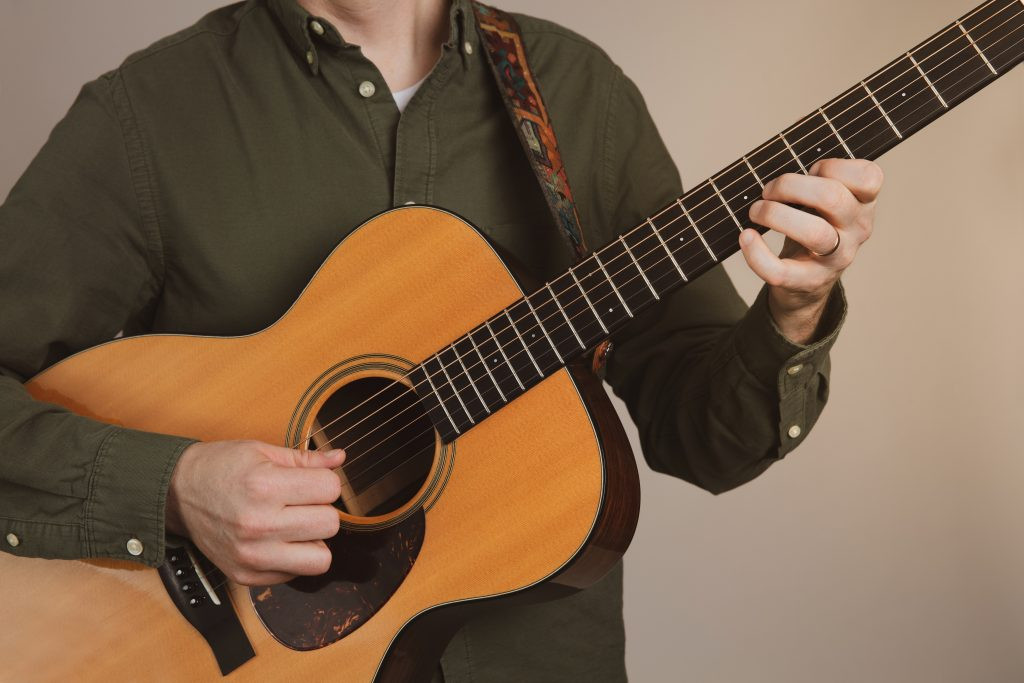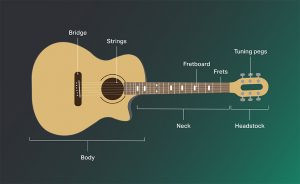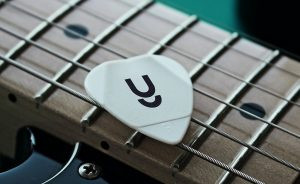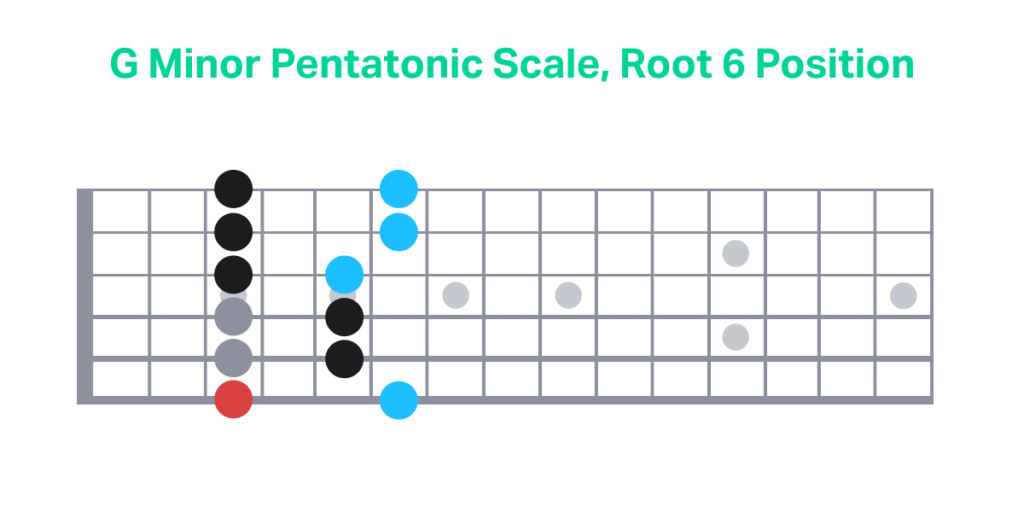Have you ever dreamt of serenading friends around a campfire, rocking out on stage, or simply enjoying the rich sounds of your favorite melodies emanating from your own guitar? Millions share this dream, and if you’re reading this, you’re likely one of them, ready to embark on an exciting musical journey. Learning to play guitar is a rewarding endeavor, accessible to anyone at any age. It’s never too late to pick up this versatile instrument and start creating music.
This guide is designed to be your starting point. We’ll walk you through the essential first steps, from choosing your ideal guitar to strumming your first chords. Consider this your launchpad towards becoming the guitar player you’ve always envisioned. Our website, guitarplayers.net, is packed with resources to further support your learning – explore the links throughout this article to deepen your understanding and accelerate your progress.
1. Acoustic vs. Electric Guitar: Which is Right for You?
The first big decision on your guitar journey is choosing between an acoustic and an electric guitar. Both are fantastic instruments, but cater to different styles and needs, especially for beginners. We have detailed guides on our site for both acoustic guitars and electric guitars, but let’s cover the basics here.
 Acoustic and Electric Guitars
Acoustic and Electric Guitars
The Allure of Acoustic Guitars
Acoustic guitars are often recommended for beginners, and for good reason. Nylon-string acoustic guitars are particularly gentle on new fingertips, making the initial learning process more comfortable. They are generally more affordable than electric setups and require no additional equipment like amplifiers. The simplicity of an acoustic guitar allows you to focus on fundamental techniques like fretting and strumming. While budget-friendly options exist, investing in a mid-range acoustic guitar ensures better sound quality and playability as you progress beyond the beginner stage. A quality instrument will inspire you to play guitar more often.
 Acoustic Guitar Close-up
Acoustic Guitar Close-up
The Power of Electric Guitars
Electric guitars offer a different kind of appeal. While often slightly pricier upfront, they are incredibly versatile, capable of producing a vast spectrum of tones, especially when paired with effects pedals and amplifiers. If your musical heart leans towards rock, blues, metal, or any genre that thrives on amplified sound, an electric guitar might be your immediate calling. Don’t let the need for extra gear deter you; starting with a basic amplifier and exploring effects later is perfectly acceptable. Learning to play guitar on an electric opens up a world of sonic possibilities.
2. Understanding the Anatomy of Your Guitar
Before you start playing guitar, familiarizing yourself with its parts is essential. Knowing the names and functions of each component will help you understand instructions, communicate with other musicians, and troubleshoot any issues you might encounter. For a more in-depth exploration, check out our guide to the anatomy of a guitar. Key guitar parts include:
- Body: The main resonant part of the guitar that amplifies the sound.
- Fretboard: The wooden strip on the neck where you press down strings to change pitch.
- Frets: Metal strips embedded in the fretboard that divide the neck into semitone intervals.
- Neck: The long wooden piece connecting the headstock to the body.
- Headstock: The top part of the neck that holds the tuning pegs.
- Strings: The vibrating elements that produce sound.
- Tuning Pegs (Tuners): Used to adjust string tension and tune the guitar.
 Guitar Parts Diagram
Guitar Parts Diagram
Depending on whether you have an acoustic or electric guitar, you’ll notice some differences. Acoustic guitars typically have a soundhole in the body to project sound naturally, while electric guitars often feature pickups, knobs, and switches to control amplified sound.
3. Mastering the Art of Holding Your Guitar
How you hold your guitar is crucial for comfort, proper technique, and preventing injuries. Whether you choose an acoustic or electric, the principles of holding the guitar remain similar, though personal preferences and playing styles can lead to variations. Our detailed guide on how to hold a guitar offers further insights.
For seated playing, acoustic guitarists commonly rest the guitar on their lap, often using a guitar strap even when sitting for better stability. The guitar body can rest on either your left or right leg, depending on your comfort and body type.
Electric guitarists also play seated, but standing with a guitar strap is equally common, especially for stage performances or rehearsals. A good quality guitar strap is essential for comfortable standing guitar playing.
 Proper Guitar Posture
Proper Guitar Posture
Orient your guitar so the thickest string (low E string) is closest to your face when you look down. The hand that presses the strings on the fretboard is your “fretting hand,” while the other hand, typically the right hand for right-handed players, is the “picking hand” or “strumming hand.” Left-handed guitarists simply reverse this.
Left-handed individuals have several options: learn on a right-handed guitar (many do!), reverse the string order on a right-handed guitar, or opt for a dedicated left-handed guitar designed for optimal left-handed guitar playing.
4. Navigating the Guitar Strings and Fretboard
The fretboard and strings are the heart of playing guitar. Understanding their layout is fundamental. Guitar strings are numbered from 1 to 6, with 1 being the thinnest (high E) and 6 being the thickest (low E). From thickest to thinnest, the standard tuning is E-A-D-G-B-e. The low E string is the one closest to you when looking down at the guitar. Delve deeper into understanding the guitar fretboard with our comprehensive guide.
Initially, pressing steel strings against the frets can cause finger soreness. Don’t worry; this is normal! Your fingertips will develop calluses and become stronger with consistent practice. Nylon strings are gentler for beginners. Ensure you press strings firmly just behind the fret, not directly on top, for a clear, ringing sound. Insufficient pressure will result in buzzing or muted notes.
5. Tuning Your Guitar to Perfection
An out-of-tune guitar makes learning frustrating and unpleasant. Accurate tuning is paramount. For beginners, mastering standard EADGBE tuning is the priority before exploring alternate guitar tunings. EADGBE represents the six strings from thickest to thinnest.
 Guitar Tuning
Guitar Tuning
Electronic tuners are incredibly convenient for both acoustic and electric guitars. However, the easiest and most cost-effective method is using a free online guitar tuner app like GuitarTuna. These apps are readily available on your smartphone, making tuning accessible anytime, anywhere. Consistent tuning practice trains your ear and is crucial for developing your guitar playing skills.
6. Unlocking Basic Guitar Chords
Before attempting complex solos, master the foundational guitar chords. Guitar chord charts are invaluable tools for visualizing chord shapes and finger placements. Start with basic open chords, often called “cowboy chords” or “campfire chords,” which are essential for countless songs. Our guide to easy chords for beginners is a great starting point. These chords are broadly categorized into major and minor chords.
If you ever forget a chord, our extensive guitar chord library is always available for reference.
Major Chords: The Sound of Happiness
Begin slowly and methodically. Learning just a handful of basic chords opens up a vast repertoire of songs! Excellent starting major chords include A, D, C, and E. Here’s the chord chart for the E major chord as an example:
[Insert E Major Chord Chart Image – if available, otherwise describe in text]
Minor Chords: Adding Depth and Emotion
Essential minor chords for beginners are Am (A minor) and Em (E minor). Minor chords are denoted with a lowercase “m.” Here’s how to play the E minor chord:
 E Minor Chord Chart
E Minor Chord Chart
Major and minor chords evoke distinct emotions. Major chords generally sound bright and happy, while minor chords have a darker, more melancholic feel. Learning to distinguish between them is crucial for musical expression in your guitar playing.
7. Mastering the Strum: Bringing Chords to Life
Strumming brings guitar chords to life, creating rhythm and musicality. To play guitar chords effectively, you strum across multiple strings simultaneously. Some chords, like D and C, require you to avoid strumming certain strings. This nuance makes some chords easier to play cleanly than others initially. Be mindful of muting strings accidentally with your strumming hand.
Once comfortable with basic open chords, experiment with upstrokes and downstrokes, diverse strumming patterns, and chord progressions. Challenge yourself with different chord types, including barre chords, which require pressing down multiple strings with a single finger – a fundamental technique for expanding your chord vocabulary.
8. Reading Guitar Tablature: Beyond Chords
When you’re ready to move beyond chords and explore melodies and riffs, guitar tablature, or “tabs,” becomes indispensable. Guitar tabs are a simplified form of musical notation, visually representing the fretboard. Numbers on horizontal lines (representing strings) indicate which fret to press. “0” signifies an open string, and “X” indicates a muted string. The bottom line represents the low E string, and the top line the high E string.
Tabs are versatile for all skill levels, showing techniques beyond basic notes, including slides, bends, hammer-ons, pull-offs, and more. Mastering tab reading unlocks a vast library of songs and techniques, enriching your guitar playing journey.
9. Picking Techniques: Precision and Dynamics
While fingerpicking (playing individual notes with fingers) is a beautiful style, using a guitar pick expands your sonic palette, especially on electric guitars. Picks are also excellent for strumming acoustic guitars. Picks vary in size, shape, and thickness, with thickness being a key factor influencing tone and playability.
 Guitar Pick Close-up
Guitar Pick Close-up
To pick individual strings, hold the pick between your thumb and index finger, keeping the other fingers relaxed. Don’t grip too tightly. The pick should protrude slightly from your thumb. Start by picking individual strings slowly, focusing on accuracy. Gradually increase speed and practice both downstrokes and upstrokes. Mistakes are part of the learning process; consistent practice refines your picking technique and precision in your guitar playing.
10. Exploring Scales: The Building Blocks of Melodies
Guitar scales and music theory might seem daunting initially, but scales are crucial for understanding the fretboard and creating melodies. Scales are ordered sequences of notes within an octave and are fundamental for improvisation and songwriting. Like chords, scales come in major and minor variations.
 G Minor Pentatonic Scale Chart
G Minor Pentatonic Scale Chart
Yousician offers excellent exercises for scale mastery. Practice playing scales ascending and descending to memorize patterns and finger positions. As your dexterity improves, increase speed to enhance your technique and fluency in guitar playing. Scales are your gateway to crafting your own guitar solos and understanding musical structure.
11. Playing Your Favorite Songs: The Joy of Music
Now for the most exciting part – playing guitar songs you love! The internet has revolutionized music learning. Forget bulky songbooks; online guitar tabs are readily available for virtually any song imaginable. Simply search for the song title followed by “tab” (e.g., “Bohemian Rhapsody tab”).
Interactive learning apps like Yousician further enhance the experience. Explore Yousician’s extensive song library spanning diverse artists and genres. You might discover tabs for your ultimate favorite guitar song waiting for you!
12. Practice Makes Perfect: Consistency is Key
Once you grasp basic chords, tuning, fretboard navigation, and tab reading, consistent practice is paramount. Make playing guitar a daily routine, even for short sessions. Finger soreness is temporary; your hands adapt, build strength, and develop muscle memory.
 Woman Practicing Guitar
Woman Practicing Guitar
Learn Guitar Basics with Yousician!
While dedicated practice is essential, remember that playing guitar should be enjoyable! Sustaining motivation is key. Yousician transforms practice into fun and engaging learning.
Yousician acts as your personalized guitar tutor, guiding you through interactive lessons at your own pace. Its vast song library provides endless guitar playing opportunities. Real-time feedback motivates improvement and makes each practice session rewarding.
Download Yousician on your computer or mobile device and begin your musical adventure today.
Frequently Asked Questions About Playing the Guitar
Starting your guitar journey often comes with questions. Here are some encouraging answers for aspiring guitarists:
How Long Does It Take to Learn to Play the Guitar?
Learning time varies greatly. Practice frequency, practice quality, and individual aptitude all play a role. Prior musical experience can accelerate learning.
Consistent practice is the key. You can progress beyond the beginner stage in months and reach intermediate level within one to three years. Guitar mastery is a lifelong journey of continuous learning and refinement in your guitar playing.
How Often Should I Practice?
Aim for 15-30 minutes of focused practice most days as a beginner. More is beneficial if you’re enjoying it! Consistency trumps lengthy, infrequent sessions. Even short daily practice accumulates to significant progress over time. Minimize distractions during practice and, most importantly, have fun playing guitar!
Do I Have to Learn Music Theory to Play the Guitar?
While not strictly mandatory initially, basic music theory enhances your understanding and accelerates progress. It aids in learning songs faster and appreciating musical structure. However, don’t let theory be a barrier to entry if your primary goal is to enjoy playing guitar and learning your favorite tunes.
How Can I Learn Guitar at Home?
Learning guitar at home is easier than ever. Online lessons and interactive apps provide structured guidance and make learning accessible without a physical teacher. These resources empower you to start playing guitar effectively in the comfort of your home.
Can I Learn to Play the Guitar By Myself?
Absolutely! Many iconic guitarists were self-taught. The internet and music learning technology provide abundant resources for self-guided learning. With dedication and readily available tools, becoming a proficient self-taught guitar player is achievable.
Ready to start playing?
Play the songs you love with Yousician. Try Premium+ free for 7 days. Sign up and start learning now.
Start your free trial
